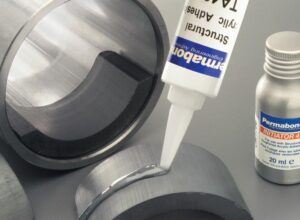
One and two component epoxy adhesives form strong resistant bonds to various types of magnets. Ask Permabond about specialty high-temperature motor magnet bonding adhesives for Class H motors.
Many high speed motor producers prefer surface activated acrylic adhesives due to the very fast set times. Alternatively, two component external mix systems are available for a one step process.
Examples of Permabond surface activated acrylic line include:
TA437
TA439
TA4590
Directions for use
Firstly, apply the adhesive to one surface, then brush or spray the initiator onto the other surface. Finally, upon assembly, strength development occurs rapidly. NOTE: If at least one surface is metal, and the process can allow for 5 to 10 minutes of fixture time before moving, consider TA437 without the initiator.
Cyanoacrylates form high strength magnet bonds very quickly. Here are a few examples:
NOTE: Without the secondary heat cure activation of the high-temperature resistance properties, Permabond 922 will only resist temperatures up to 180 degrees F (82C)
Choose an epoxy or structural acrylic adhesive for higher impact strength or more resistance to polar solvents.
Permanent magnets are made from hard ferromagnetic materials. Magnet types vary in strength, cost, temperature and corrosion resistance. Typical magnet types include neodymium, rare-earth, samarium cobalt, AINiCo, and ferrites. All of these magnet types can usually be bonded as received but for highest strength or if the surface is contaminated cleaning with isopropanol is recommended. A variety of industries use adhesives to bond magnets; most notable are electric motors and speakers. See the complete line of electric motor adhesives and speaker adhesives.